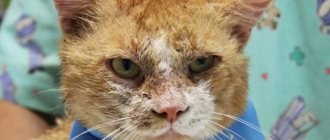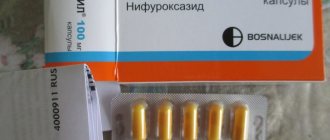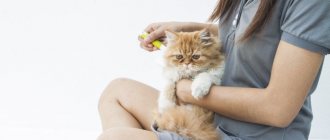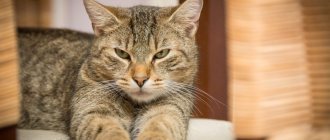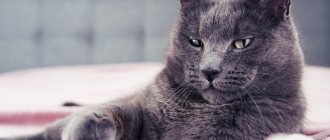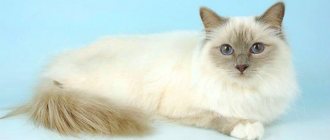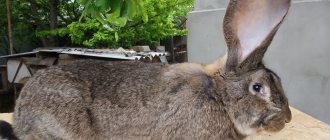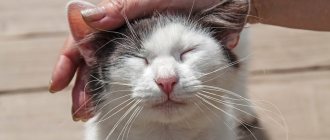Diarrhea in cats is a condition characterized by frequent bowel movements and one large, unformed stool. Diarrhea can be acute or chronic. In almost all cases, this condition occurs as a result of increased intestinal motility, which can be caused by a variety of irritating factors. Diarrhea is one of the symptoms that may indicate systemic failures, pathologies in the animal’s body, and possible infectious diseases. By the consistency, color, and smell of stool, you can determine the possible causes of illness. What to do if you notice green diarrhea in your cat? How to treat acute diarrhea?
Symptoms of diarrhea in cats
Diarrhea in a domestic cat cannot go unnoticed. When the stool is upset, the pet often visits the litter box and goes to the toilet loosely. In this case, feces may have a foul odor and a different consistency - watery, mushy, mixed with mucus and blood.
Stools with diarrhea come in different colors - yellow, black, greenish and even white. It is important to monitor the clinical picture, as additional symptoms will help to accurately establish the diagnosis. Loose stools in a cat are often accompanied by a general deterioration in health:
- loss of appetite;
- oppression;
- increased temperature;
- vomiting;
- rapid weight loss.
Attention! Diarrhea with vomiting is especially dangerous in a kitten, in which fluid loss occurs very quickly. In such a situation, the pet needs urgent help.
It also matters how long the loose stool lasts. There are 3 types of diarrhea:
- acute – duration 1–2 days;
- chronic – more than a week;
- intermittent or recurrent - diarrhea occurs periodically.
Diarrhea symptoms
Regardless of the etiology (i.e. origin) of diarrhea, all its types can be divided into two large types:
- Acute diarrhea.
- Chronic diarrhea.
Accordingly, the symptoms of these two varieties will differ significantly.
Signs of acute diarrhea
In this case, everything is quite simple and clear. First, you need to decide on the terminology: “acute” diarrhea is called in cases where it began suddenly and lasts no more than two days, accompanied by a significant deterioration in the condition of the sick animal.
The following signs of such diarrhea are distinguished:
- Defecation is frequent, the animal constantly runs to the tray.
- As a rule, feces are liquid; they often contain impurities in the form of mucus, half-digested pieces of food, and sometimes blood can be seen.
- After just five or six trips to the potty, the animal begins to meow hoarsely, constantly licking the anus area.
- If diarrhea continues for more than two days, the cat becomes noticeably weaker. In the most severe cases, the pet practically stops grooming itself, its fur becomes matted and becomes covered with a crust of dried feces.
- In the same cases, severe blanching of all visible mucous membranes is observed. They become dry and sticky to the touch. The skin loses its elasticity, the coat becomes rough and hard.
If such signs appear, the cat should be immediately shown to a veterinarian, since this clinical picture directly indicates a serious degree of dehydration. If you delay in contacting the clinic, the animal may die.
The following conclusions can be drawn from all of the above:
- If diarrhea lasts less than a day, and the general condition of the animal at this time remains stable and does not cause alarm, you can try to cope with diarrhea on your own.
- In cases where a cat suffers from diarrhea for more than a day, and its condition is slowly but deteriorating, you should definitely show the animal to a veterinarian. This precaution will certainly not be superfluous.
Signs of chronic diarrhea
As you can understand, “chronic” diarrhea does not imply the cat constantly sitting on the tray. In this case, the animal will simply die from dehydration and exhaustion.
This type of pathology manifests itself somewhat differently:
- Diarrhea occurs sporadically, not every day.
- Interestingly, cases of diarrhea may well alternate with periods of “impenetrable” constipation.
- The cat’s condition “by eye” remains normal, but this impression is wrong. If nothing is done and the true root cause is not identified, the animal will gradually develop exhaustion.
Types of diarrhea and preliminary diagnosis by stool color
If your cat is diarrhea, you need to pay attention to the color and structure of the stool. This will help clarify the clinical picture and make the correct diagnosis.
Any information is important to make a diagnosis
Loose stools happen:
Diarrhea with water
Watery stool of normal color should not cause concern if diarrhea occurs 1-2 times. This sometimes happens due to a sudden change in diet, under stress, for example, after a trip to the veterinarian or after moving. A kitten has diarrhea with water due to the introduction of new food into the diet. Babies' intestines are weak; any changes in the menu can cause bowel upset.
Green diarrhea in a domestic cat
Feces acquire a greenish tint when pathogenic microflora develops in the intestines. Putrefactive processes can begin due to eating low-quality, spoiled food or due to dysbiosis. This is a potentially dangerous situation as harmful bacteria in the digestive tract continue to multiply and release toxins, poisoning the entire body. You need veterinarian help if diarrhea lasts more than 2 days.
Greenish stool with mucus
White diarrhea in a cat
White, loose stool in a pet is a reason to contact a veterinary clinic. Such feces indicate serious problems with the liver and gallbladder. Discoloration of stool is often caused by difficulty producing bile. Even if your cat has white diarrhea only once, you should not put off visiting the veterinarian.
Black liquid stool
The stool color is too dark if the animal eats a lot of iron-containing food - raw meat with blood, or takes iron supplements. Otherwise, black stools indicate internal bleeding. It can occur for various reasons, for example:
- as a result of a blow or fall from a height;
- due to helminthic infestation;
- with hemorrhagic gastroenteritis;
- due to a tumor in the intestine.
Yellow diarrhea
Light brown or yellowish runny stool is a common occurrence in pets. This color of feces indicates that food is poorly digested. Too bright a shade of yellow may indicate liver problems. Perhaps your pet ate something fatty or drank a lot of milk. Having discovered such a symptom, it is best to put the cat on a starvation diet for 8–12 hours and observe him. If the diarrhea does not stop, you will have to undergo tests to identify liver pathologies.
With blood or mucus
Blood in the stool is a warning sign. Sometimes the cause of this symptom is a foreign body that the pet has swallowed. As it moves through the intestines, it can damage its wall, hence the blood. Other reasons for the appearance of bloody streaks are inflammation of the intestinal mucosa, cracks inside the anus.
Diarrhea with mucus indicates infection with worms. A large amount of mucous secretion in the feces is detected after deworming.
Diarrhea and vomiting
When food or chemical poisoning occurs, cats develop diarrhea and vomiting. This condition can also be caused by an infectious disease or heat stroke. The body becomes dehydrated very quickly, so emergency assistance is needed. To replenish the fluid balance in the body, you need to water the cat or inject a glucose solution under its withers.
Main predisposing factors
The causes of diarrhea in kittens are extremely varied. This includes both simple stress (including weaning and moving to a new home) and very serious pathologies, including feline panleukopenia. Very often, diarrhea is a consequence of using low-quality feed.
Let's consider several situations in which a kitten's feces can turn greenish:
- Overfeeding.
- Cow's milk. The digestive tract of many kittens cannot digest it at all. In the lumen of the intestines, many casein clots form, which rot.
- Spoiled food.
- Changing your diet.
- Weaning from mother.
- Stress.
- Helminthiases.
- Protozoal infections. “Green” diarrhea is especially characteristic of giardiasis and cryptosporidiosis.
- Bacterial or viral infections (for example, infectious enteritis).
- Diabetes.
- Oncological diseases.
Causes of intestinal distress in pregnant and lactating cats
While carrying kittens, the cat's immune system becomes vulnerable, so she can easily catch a viral or bacterial infection. It is important to monitor the quality of food that the expectant mother receives to minimize the risk of developing diarrhea. A pregnant cat should not be introduced to new foods or given fatty foods, as this can cause bowel upset. Brief diarrhea sometimes occurs a day or two before the onset of labor; this is considered normal.
Cats have diarrhea after giving birth
When diarrhea occurs shortly after lambing, a possible cause is eating the placenta. Changes in hormonal levels also affect the functioning of the intestines, so there is no need to worry about short-term bowel disorders after childbirth.
Attention! Some owners of nursing cats give them a lot of whole milk to drink, which causes loose stools. It is better to replace it with fermented milk products - fermented baked milk, cottage cheese or whey.
What to do if your cat has diarrhea
Having discovered that your cat has severe diarrhea without complications, the first thing to do is remove food from his bowl. The drinking bowl should be washed and fresh water added. Your pet needs rest. It is advisable to place it in a separate room. If there are other furry inhabitants in the house, it is better to limit their contact with the sick pet.
The animal's condition should return to normal within 12–24 hours. If the diarrhea does not go away, you need to schedule a visit to the veterinary clinic and go there as soon as possible. These recommendations do not apply to cases where the cat:
- bloody, black, white diarrhea;
- diarrhea accompanied by vomiting;
- increased temperature;
- coordination of movements is impaired;
- convulsions.
Having discovered such symptoms, you cannot wait a day - the animal may die due to internal bleeding, chemical poisoning and intoxication. In these cases, the cat needs to be examined to determine the real cause of the disease. The veterinary clinic will take tests, do an ultrasound of the internal organs and prescribe a treatment regimen. Your pet may need surgery.
Treating diarrhea in a cat at home
In cases where diarrhea is not complicated by vomiting, high fever, and there are no signs of internal bleeding, it can be cured without the help of specialists. The main rule for intestinal upset is to give you more water to drink. If the animal does not approach the drinking bowl, you will have to unsolder it from the syringe with Regidron solution, removing the needle. There is no need to offer your cat food for the next 24 hours.
Further, if the condition improves and the interval between bowel movements increases, you can start feeding your pet. Veterinarians recommend giving therapeutic and preventive food for diarrhea. They do not irritate the intestinal mucosa, are easily digested, help eliminate toxins and consolidate stool.
Medicines for cats for diarrhea:
- Smecta. The safest sorbent, approved even for small children. Helps remove intoxication and consolidate feces. A quarter of the sachet is diluted with water and 5 ml is poured into the pet’s mouth from a syringe 4 times a day.
- Bifidumbacterin. Probiotics help normalize intestinal microflora and are absolutely harmless. The contents of the bottle are diluted with water (5 ml) and given to the pet to drink.
- Activated carbon. A sorbent that everyone has in their home. Effectively fights poisoning and removes toxic substances from the body. Dissolve ¼ tablet in a small amount of water. Give your cat a drink in the morning and evening.
- Enterosgel. New generation sorbent. Effective against intestinal infections, as it prevents the proliferation of pathogenic bacteria. Directions for use: squeeze 0.5 cm of gel out of the tube and dilute it in a tablespoon of water. Give your pet 3–5 ml 3 times a day.
Attention! Treatment of diarrhea in a cat at home cannot last more than 1–2 days. If symptoms persist, consult a veterinarian. Perhaps diarrhea is caused by a viral infection or pathologies of internal organs. In this case, the doctor will determine the treatment regimen.
Prevention measures
To prevent diarrhea in a cat, you must adhere to simple preventive measures:
- regularly examine your pet for parasites;
- get vaccinations to strengthen the immune system;
- feed only high-quality feed;
- do not change the type of food, which can cause intestinal disorders.
During walks, do not allow your pet to come into contact with street animals, especially homeless ones.
Antibiotics and sulfonamides for diarrhea
Sorbents and probiotics can be given to a cat for diarrhea without a veterinarian's prescription, but with antibiotics and intestinal antiseptics the situation is different. Treatment of diarrhea in infectious diseases is not limited to just relieving symptoms. Complex therapy may be needed, including taking antiviral agents, immunostimulants such as Anandin, Cycloferon, as well as antibacterial or sulfonamide drugs.
Levomycetin
This medicine is effective against gram-positive bacteria - enterococci, streptococci and staphylococci, as well as against gram-negative ones - Escherichia coli and Haemophilus influenzae, Shigella, Salmonella, Klebsiella, etc.
How to give a cat a pill
Levomycetin for cats for diarrhea, dosage: ¼ tablet 2 times a day. The medicine is very bitter, the pet is unlikely to swallow it in its pure form. You can use a trick - hide a quarter of the tablet in a small crumb of bread. The ball is placed on the root of the animal’s tongue, its mouth is closed and the throat area is stroked to provoke a swallowing movement.
Reference. If you cannot give the medicine orally, you can administer it intramuscularly. Your veterinarian will tell you how to dose the drug in this case.
Phthalazole
A sulfanilamide drug with a bacteriostatic effect. Used for enterocolitis caused by intestinal infections. The dose is determined by the weight of the animal - 100 mg of the substance per 1 kg of weight. For a cat weighing 2.5 kg, the daily dose is 250 mg (half a tablet). It must be divided into 3-4 doses. The course of treatment is 4–5 days.
Furazolidone
The nitrofuran drug Furazolidone is given to a pet only as prescribed by a veterinarian. It effectively fights bacteria and fungi in the intestines. Dosage for an animal is 5 mg of the substance per 1 kg of weight. A cat weighing 5 kg is given half a tablet (25 mg) per day, dividing it into 2-3 doses at equal intervals.
Enterofuril (Nifuroxazide)
Nitrofuran drug for diarrhea of infectious etiology. For the treatment of cats, it is better to use a suspension of 200 mg/5 ml. The daily dose for a pet is 200 mg or 5 ml, it should be divided into 3 doses, 1.7 ml each.
Other antibiotics
The veterinarian may prescribe other antibacterial drugs to treat diarrhea:
- Metronidazole;
- Ciprofloxacin;
- Amoxicillin.
After taking antibiotics, it is necessary to restore the animal's intestinal microflora. Veterinarians recommend giving your pet probiotics - Linex, Bifidumbacterin.
How long can diarrhea last?
global $ads_google; //data-ad-slot=”2475549904″ $ads_google = empty($ads_google) ? false : true; ?> if ($ads_google == false) {?>
$ads_google = true; ?> } ?>
Duration of diarrhea with a frequency of 2-3 times a day can very quickly lead a kitten to severe dehydration. Replenishing lost fluids at home can be challenging. Duration of up to three days is critical; it is better not to wait so long and consult a doctor.
Nutrition during treatment
In case of diarrhea, the cat is not fed in the first 12–24 hours, and drinking is not limited. Feeding can be resumed when the animal develops an appetite and the number of bowel movements decreases. In case of poisoning and infectious diseases accompanied by loose stools, pets are not given food from the table. During illness, they offer canned therapeutic and prophylactic food. The daily dose of food is reduced by 2 times and divided into 5-6 meals. The cat should eat in small portions. Diets are followed throughout the entire course of treatment until complete recovery.
It is very important to replenish fluid loss in your pet's body. The cat needs to drink water; if he refuses, you will have to pour Regidron solution 5-7 ml into his cheek up to 10 times a day. Another way to restore the water-salt balance is to inject sodium chloride and glucose solution subcutaneously, 20-40 ml at a time.
Subcutaneous injection in a cat
Prevention of diarrhea
Most often, diarrhea in domestic cats develops due to dietary errors, so it is important to follow the recommendations of veterinarians:
- feed animals with the same brand of food;
- do not exceed the dosage specified by the manufacturer;
- Do not put too much wet food in the bowl - it may spoil at room temperature;
- Do not give your cat fatty foods - pork, lard, smoked meats;
- You cannot treat your cat with salted fish and raw meat.
Veterinarians recommend deworming twice a year, because worms are one of the causes of diarrhea. To protect your animal from infectious diseases, you should limit contact with street cats and get vaccinated in a timely manner.
The health of a pet largely depends on the quality of its care. The cat owner needs to be attentive, watch her, notice any changes in behavior and well-being and respond to them. Diarrhea that does not stop within one day is a reason to seek veterinary help. Self-medication can lead to a worsening of the situation and even death of the pet.
If you find green feces in the litter box, your cat has health problems. Change in color of excrement is accompanied by diarrhea. Depending on what symptoms accompany such a deviation, one can judge whether the pet has a particular disease.
What's the normal color?
Feces in cats, like in humans, can tell everything about their health. The cat poops in dense, well-formed masses that are brown or dark brown in color. The consistency of excrement depends on the content of liquid, fat, and mucous components. The smell of feces is not unpleasant, not strong, this smell is called feces. If the diet is dominated by dairy and fermented milk products, cereals, and vegetables, the mass acquires a light brown tint. When a pet eats mainly meat, the excrement becomes a more saturated dark color.
Causes of changes in stool color
The color of excrement in a kitten or cat without the disease is brown. Otherwise, you should be wary, paying attention to the accompanying signs.
So, depending on the color and consistency of an animal’s excrement, it can be assumed that it has the following health problems::
- Black feces indicate the appearance of worms, the development of gastritis, the formation of a tumor or ulcer in the gastrointestinal tract. At the same time, the cat’s temperature rises, he experiences stomach pain, refuses to eat, and vomits.
- The yellow color of the excrement, if it is too saturated, indicates that the cat has jaundice.
- White diarrhea appears due to a lack of bilirubin. The reason for this is impaired liver function.
- Greenish feces in cats cause fermentation or rotting in the intestines. This may happen because the animal has eaten rotten food. In this case, he may be at risk of poisoning.
Causes of diarrhea in a kitten or cat
A variety of factors can be responsible for the appearance of loose stools in a cat. First of all, these are various pathologies: inflammation of the gastrointestinal tract, uncontrolled use of antibiotics, intoxication, parasites, various infections. The list also includes oncology and diabetes.
Pathological causes of diarrhea in cats include diseases of internal organs not directly related to the gastrointestinal tract. These are diseases of the kidneys and liver, pancreas, and sometimes fungal infections.
In particularly dangerous cases, the cause may be a foreign body stuck in one of the intestinal sections. It usually causes severe pain in the pet. It is easy to determine soreness: you need to palpate (feel) the abdomen. If the cat is in pain in one specific place, it is necessary to urgently go to the veterinary hospital. Soreness does not always indicate a foreign body, but it is better to be on the safe side.
There are breeds that are the most picky about diet and new dishes. Devon rexes and Canadian sphinxes are considered such animals. They have a rather unstable digestive system, so stool failures occur frequently.
The cause of diarrhea in a cat is not always caused by something dangerous - there is a possibility that the following factors have a negative impact:
- change of feed;
- excess fatty foods;
- binge eating;
- stress.
In this case, you can avoid contacting a veterinarian, but stabilize your pet’s condition by returning to normal food and a gentle lifestyle. If you notice diarrhea and vomiting in a kitten or a pregnant female, in any case you need medical advice.
Associated symptoms of diarrhea in cats
In addition to loose green stools, the following symptoms may indicate diarrhea::
- Increased body temperature.
- Change in animal behavior.
- The cat is thirsty all the time.
- The pet's body weight decreases.
- The quality of the cat's fur becomes poor.
- The mucous membranes of the animal turn pale.
- Appetite disappears.
Green stool in a kitten with a liquid consistency, turning into a chronic condition, leads to dehydration of the animal’s body and the accumulation of toxins in it. In this case, metabolic processes are disrupted. The kitten's growth and development slow down.
What to do when your cat has green diarrhea
If foam, mucus, or blood appears in your cat’s excrement and the animal’s health worsens, you should immediately contact a veterinarian. Self-treatment in this case can lead to the death of the pet.
The veterinarian will order tests for the cat. After conducting research, he will be able to determine the reason why the cat’s green stool has become a problem. Most often, the animal is prescribed a diet, conservative treatment and IV drips. The cat must be treated strictly according to the veterinarian's prescription so as not to worsen its condition.
If there is no threat to the life and health of the cat, then diarrhea can be eliminated on your own. She can make rice water, which will help cope with diarrhea. A decoction of oak bark will help prevent the inflammatory process. It can be found at a pet store.
Diarrhea in a cat is an unpleasant phenomenon neither for the animal itself nor for its owner. Diarrhea may be short-lived and usually goes away on its own. But often this is a symptom indicating serious illnesses in the animal that are life-threatening.
Norm or pathology
Normally, a cat should go to the toilet no more than twice a day. The feces of a healthy pet are formed, brown, and soft.
If a cat has diarrhea, the number of visits to the toilet increases sharply (up to 10 times a day). The stool becomes thin, watery, smells bad, and the color of the stool often changes.
Diarrhea in a cat can last from one day to several weeks or occur periodically over many months.
It is customary to divide feline diarrhea into three forms:
- Acute – lasts several days, but no more than 2 weeks. There is a high risk of dehydration.
- Chronic – more than 2 weeks. With constant diarrhea, nutrients and vitamins are poorly absorbed. This leads to weakened immunity and exhaustion. Without adequate treatment, the animal will not get better.
- Constant or recurrent - loose stools occur periodically in a cat for a month or more.
To choose effective treatment, you need to find out the cause of the disorder.
Prolonged loose stool in a cat leads to water and electrolyte imbalance, which can result in the death of the animal. Therefore, the help of a veterinarian is required.
Provoking factors
The following factors can cause acute or persistent diarrhea in a cat:
- Helminths and protozoa (Trichomonas, Giardia, Isospora). The intestinal mucosa is irritated during the life of endoparasites, and the absorption of nutrients is disrupted. Worms are a common cause of bowel movements in kittens, but are also common in adults. Protozoan parasitic organisms pose a particular problem, since they are not affected by traditional anthelmintic drugs. They often cause the cat to have diarrhea with mucus and blood.
- Infections. Infection with viruses or bacteria can cause intestinal upset in a cat. It occurs more often in young cats and unvaccinated animals. Diarrhea caused by infection is often accompanied by fever, lethargy, and sometimes vomiting.
- Inflammatory diseases of the gastrointestinal tract, intestinal tumors (lymphoma). So, if feces come out in small portions, several times in 1 hour, the possible cause is inflammation of the colon (colitis).
- A sudden change in diet. This is one of the most common causes of diarrhea. Also, the pet may eat something atypical for it. Houseplants, due to their toxin content, often cause cats to have loose stools, stomach upset, and vomiting.
- Binge eating. When a lot of food comes in, the intestines begin to contract more actively, and the contents quickly pass in liquid, unformed form into the rectum. Excess food leads to the fact that the cat goes to the toilet loosely. Reducing portions will help stop diarrhea.
- Poisoning. A cat can be poisoned by poor-quality food, chemicals, or medications. At home, pets are most often poisoned by detergents containing chlorine. The first signs of intoxication are an upset stomach in the cat, accompanied by vomiting and loose stools.
- Stress. Just like in people, stressful situations can cause a cat's stomach upset and intestinal irritation. In animals, this condition is provoked by a change of place of residence, moving, or the appearance of a new pet.
- Operations on the genital organs. Diarrhea in a cat after sterilization or castration is caused not only by stress, but also by anesthesia medications.
- Antibacterial therapy. Diarrhea in a cat after antibiotics is not uncommon. Such drugs destroy not only pathogenic, but also beneficial intestinal microflora.
- Constipation. Older animals may experience alternating constipation and diarrhea.
- Metabolic diseases. Due to malfunctions of the liver, pancreas, and thyroid gland, an imbalance of microflora is disrupted.
What treatment is prescribed?
Medication
Depending on the diagnosis, the veterinarian selects the most optimal treatment regimen, which often includes the following groups of drugs:
Dicynone is able to stop a minor source of bleeding in an animal.
- Hemostatic. If diagnostics show that the cat is developing internal bleeding, but it is not life-threatening, the doctor will prescribe medications that can prevent the loss of vital fluid. Effective drugs in this group: “Dicinon”;
- "Tranexam";
- "Vikasol".
- "Penicillin";
- "Interferon";
- "Pyrantel";
- "Maalox";
Surgical
Sometimes surgery is the only option for an animal to return to normal.
Sometimes it is impossible to normalize a pet’s condition with medications alone, for example, with heavy internal bleeding. To save the animal's life, the doctor decides to perform surgical treatment. The manipulations are performed under general anesthesia. After the operation, a long recovery will be required, during which it is important for the owner to control the diet of his four-legged friend, as well as give him medications prescribed by the doctor to prevent the development of inflammatory processes and increase the body's defenses.
Types and nature of diarrhea
The color of the stool helps determine which part of the intestine the problem is in. And the presence of impurities in them (blood, mucus, food debris) always indicates illness.
Yellow
Bright yellow diarrhea in a cat indicates problems with digestion of food.
This happens if your pet has eaten fatty foods or drunk milk. If a fasting diet for 8-10 hours does not lead to improvement, you should check your liver.
Green
The active activity of putrefactive bacteria is most often indicated by green diarrhea in a cat. A pet may diarrhea if poisoned by low-quality products. The stool develops a putrid odor and contains greenish inclusions.
White
If the feces are white, it means there is a problem with the flow of bile into the gastrointestinal tract. Its lack leads to indigestion. It is bile that makes feces brown. Even a single case of white feces is a reason to examine the liver, pancreas and gall bladder. Stagnation of bile is one of the causes of intoxication of the body.
The gray color of stool occurs due to impaired absorption and digestion. The same reason leads to oily diarrhea, after which the cat has greasy hair under the tail.
Light-colored feces with a foul odor are possible due to a viral infection, such as distemper, and this is a reason to urgently contact a veterinarian.
Black
The consequence of eating raw meat or iron supplements can be black diarrhea. If these 2 factors are excluded, then there is a risk that the pet has internal bleeding. The reasons for this are worms, tumors, and inflammation in the small intestine (gastroenteritis).
Diarrhea comes with water
Watery stools are characteristic of diseases of the small intestine, particularly enteritis. Inflammation occurs due to irritation of the walls by toxins or infection. Substances quickly pass through the intestines and do not have time to be absorbed.
Diarrhea with mucus or blood
Loose stools with mucus are often associated with infection with worms or the presence of inflammation.
Bloody inclusions may indicate inflammation of the intestinal mucosa, possible anal fissures, the presence of worms, polyps, and bacterial infections. Often bloody stools have an unpleasant putrid odor.
Blood in stool with diarrhea can be scarlet and black, like tar. Scarlet blood - problems with the large intestine, possible oncology, worms. Dark blood indicates disturbances in the upper gastrointestinal tract.
If diarrhea is accompanied by bloody discharge, refusal to eat, or weight loss, you should immediately contact a veterinarian.
